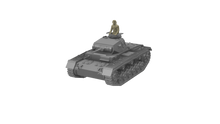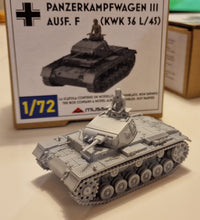Il Panzerkampfwagen III (codice identificativo Sd. Kfz. 141) fu progettato come il carro da battaglia che avrebbe dovuto costituire l'ossatura delle nascenti Panzerdivisionen. Nella concezione tedesca della prima serie di progetti, al Panzer I era infatti affidato il ruolo di veicolo da addestramento, al Panzer II quello da esplorazione, per i reparti da ricognizione, mentre al Panzer IV sarebbe spettato l'appoggio ravvicinato alle truppe, in virtù del suo obice da 75 mm in dotazione.
Il modello III, invece, doveva essere nelle intenzioni dei vertici della Wehrmacht il carro principale delle formazioni corazzate, a cui sarebbe spettato il compito di affrontare i mezzi nemici. Lo scoppio della guerra con la Polonia, però, arrivò prima del previsto e prima che il veicolo fosse distribuito in buon numero ai reparti: sugli oltre 2500 carri armati impiegati contro l'esercito polacco, solo 98 erano del modello III.
La produzione venne intensificata nei mesi di "Sitzkrieg", la strana situazione di effettiva non belligeranza che rimase sul fronte franco-tedesco da settembre '39 a maggio '40, e durante l'offensiva scatenata contro Francia, Belgio e Paesi Bassi il 10 maggio 1940 il Panzer III fu effettivamente impiegato in buon numero contro i carri delle divisioni meccanizzate francesi.
Il modello riprodotto in scala 1/72 appartiene alla serie F, la prima ad essere prodotta su larga scala, dopo una serie di cambiamenti al progetto iniziale e di migliorie. Era armato del cannone Kwk 36 L/45, l'equivalente del pezzo anticarro da 37 mm che costituiva l'armamento standard delle divisioni di fanteria della Wehrmacht all'inizio del secondo conflitto mondiale. Alla prova del fuoco, l'armamento si rivelò inadeguato per affrontare i blindati più pesanti inglesi e francesi, così come si valutò necessario incrementare lo spessore della corazzatura frontale.
In ogni scatola Mussini models c'è un modello di Panzer III suddiviso in 5 parti: torretta, scafo superiore, scafo inferiore, e blocchi laterali di ruote e cingoli. Sono inclusi, inoltre, una torretta con gli sportelli aperti e il figurino di un capocarro.
Prodotto non adatto a minori di 14 anni. Pitture, colle e altri materiali non sono inclusi nella confezione. Alcune parti potrebbero essere piccole o con sporgenze affilate.
Note
L'articolo viene venduto NON dipinto.
E' possibile ordinare l'oggetto dipinto previa richiesta informazioni all'indirizzo info@mussinisas.it.
The Panzerkampfwagen III (identification code Sd. Kfz. 141) was designed as the battle tank that should have formed the backbone of the nascent Panzerdivisionen. In the German conception of the first series of projects, the Panzer I was in fact entrusted with the role of training vehicle, the Panzer II that of exploration, for the reconnaissance departments, while the Panzer IV would have been assigned close support to the troops, by virtue of its supplied 75 mm howitzer.
The III model, on the other hand, must have been the intention of the Wehrmacht leaders to be the main tank of the armored formations, which would have had the task of facing enemy vehicles. The outbreak of war with Poland, however, arrived earlier than expected and before the vehicle was distributed in good numbers to the departments: out of over 2500 tanks used against the Polish army, only 98 were of the III model.
Production was intensified during the months of "Sitzkrieg", or Phony War as was called in England, the strange situation of effective non-aggression which remained on the Franco-German front from September '39 to May '40, and during the offensive unleashed against France, Belgium and the Netherlands on May 10 1940 the Panzer III was actually used in good numbers against the tanks of the French mechanized divisions.
The model reproduced in 1/72 scale belongs to the F series, the first to be produced on a large scale, after a series of changes to the first project and improvements. It was armed with the Kwk 36 L/45, the equivalent of the 37 mm anti-tank gun which was the standard armament of the Wehrmacht's infantry divisions at the start of the Second World War. After the test of the battles on the western front, the armament proved inadequate to deal with the heavier British and French armored vehicles, just as it was deemed necessary to increase the thickness of the frontal armour.
In every Mussini models box there is a Panzer III model divided into 5 parts: turret, upper hull, lower hull, and side blocks of wheels and tracks. Also included is a turret with open doors and a commander figure.
Disclaimer
Product not suitable for children under 14 years. Paints, glues and other materials are not included in the package. Some parts may be small or have sharp protrusions.
Note
The item is sold NOT painted.
It is possible to order the painted object upon requesting information to the address info@mussinisas.it.






